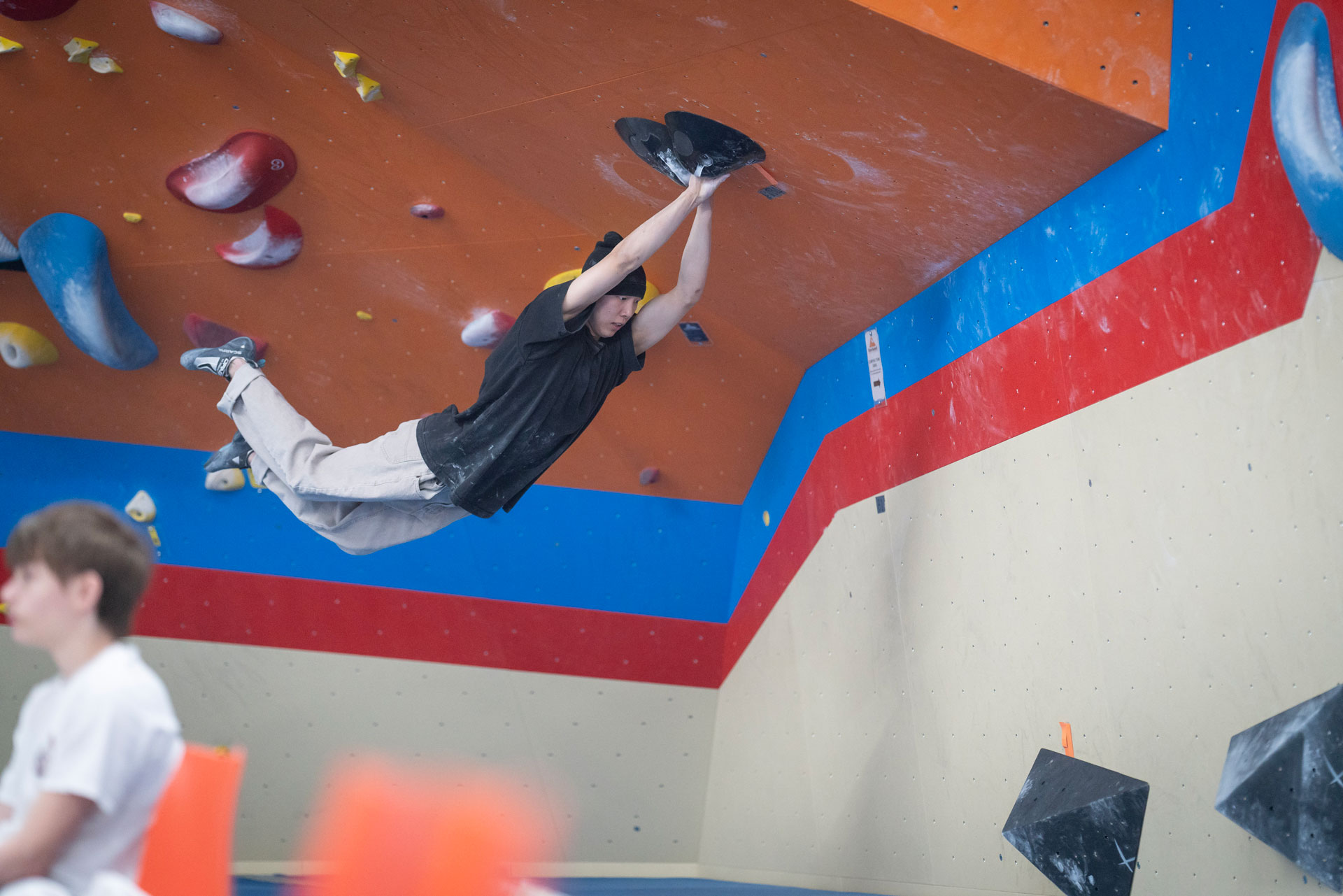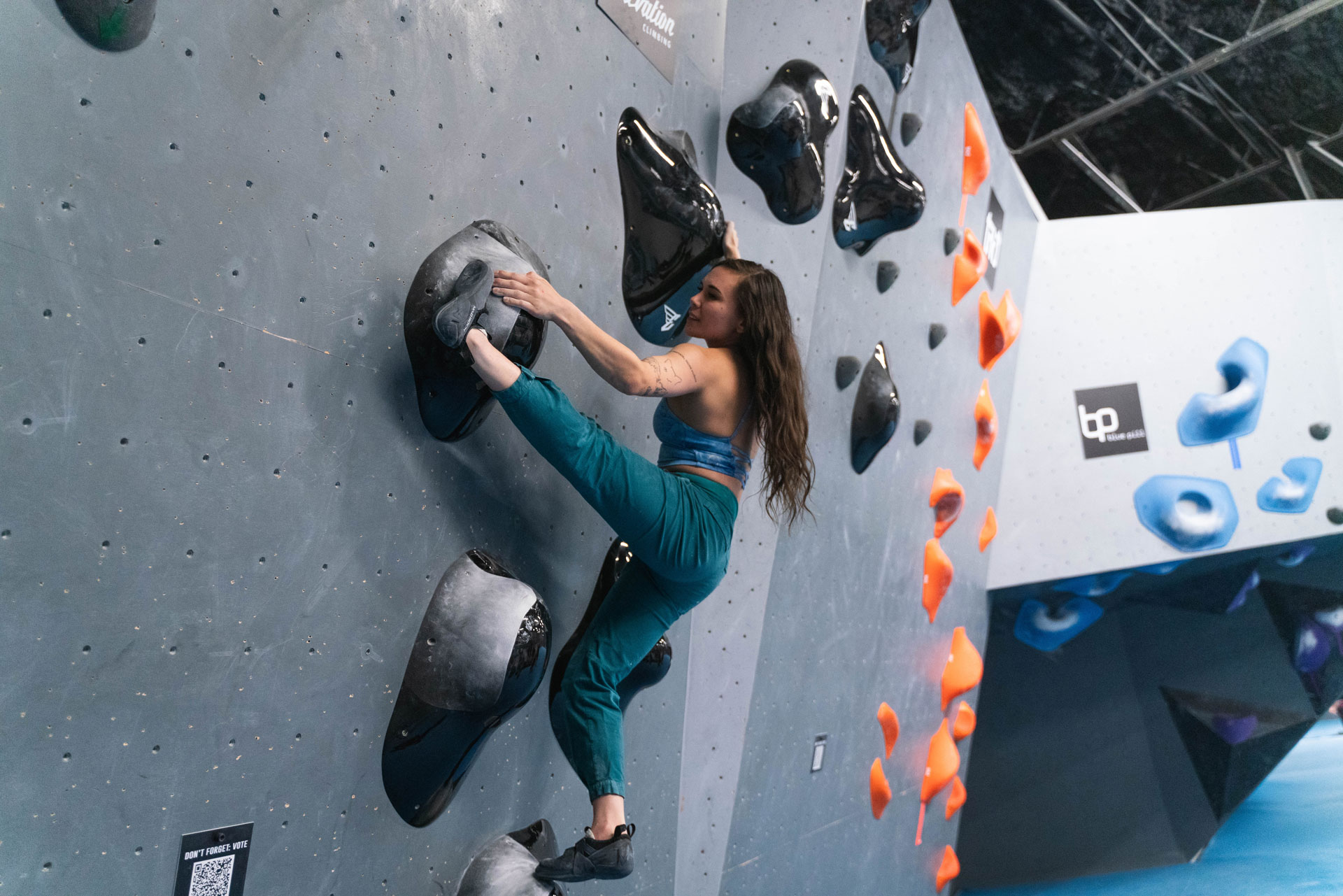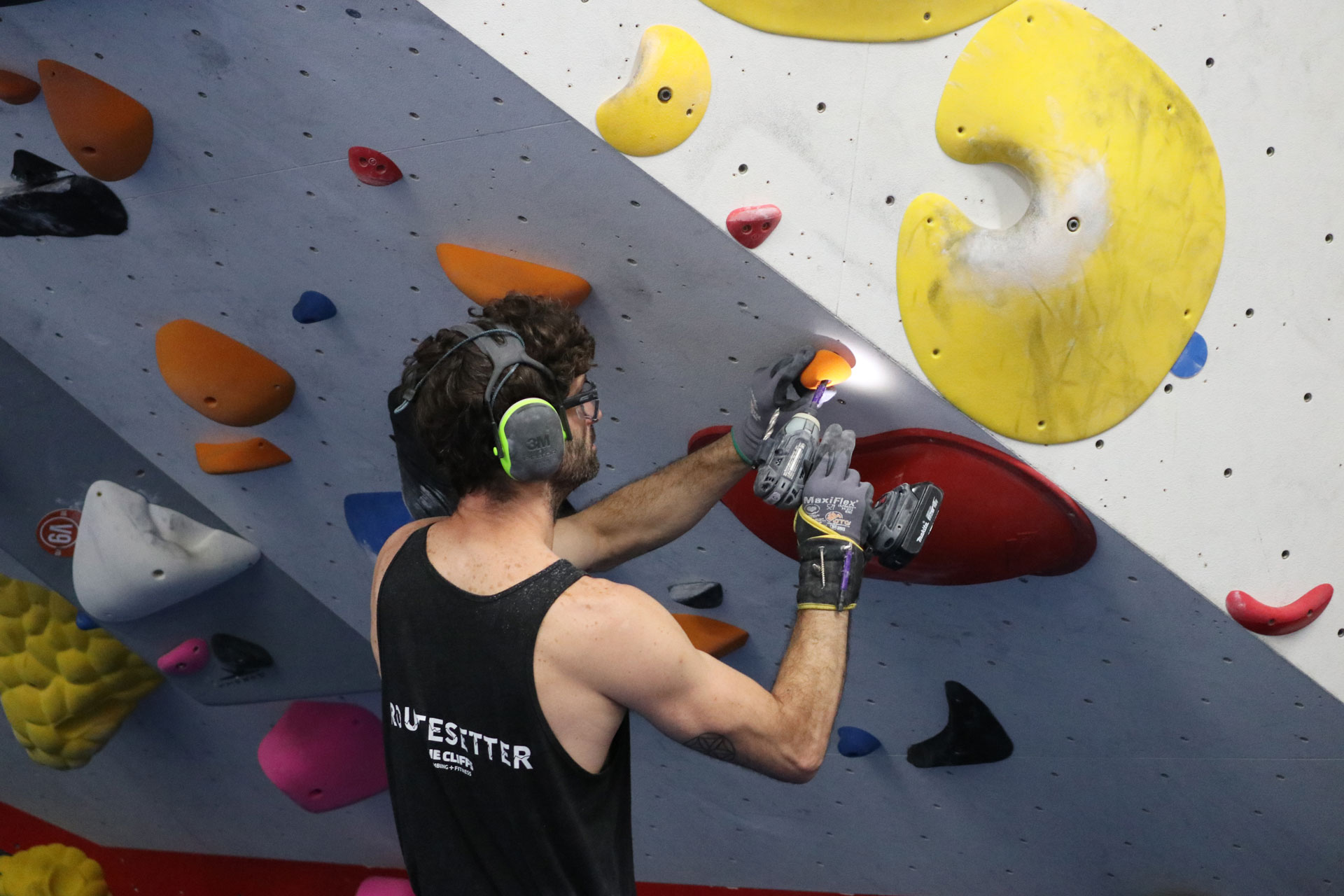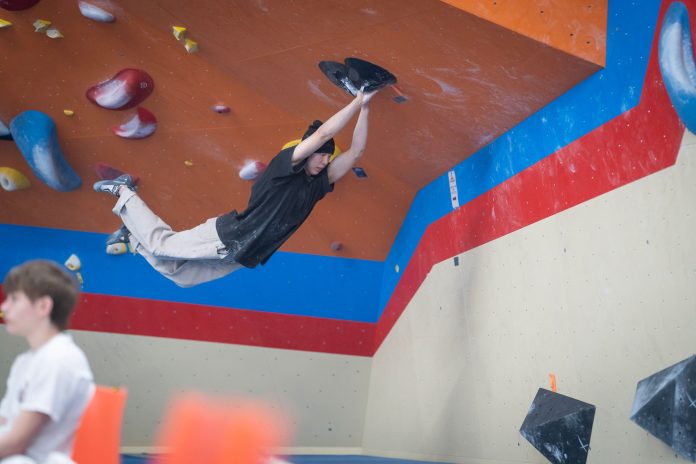
As we look back on 2023, it becomes increasingly clear that the year featured some unique developments in the world of routesetting—developments that were separate or idiosyncratic to the annual developments in other areas of the climbing gym industry. So, as something of a compendium to the forthcoming 2023 Gyms & Trends Report, we have compiled a list of some routesetting trends of 2023. This is not intended to be an exhaustive list; in fact, each gym likely has its own routesetting trends that stem from the unique interests and climbing predilections of its community. In some cases, those local (or regional) trends might be similar or identical to the trends listed here, but in other cases they might be different.
On the whole, volumes seemed more ubiquitous than ever in 2023, and social media likely played a role in inspiring an unprecedented number of routes. “Maybe the big trend is this idea that there are plenty of moves that are still out there that are cool, exciting, valid climbing moves and experiences,” Level 5 National Chief Routesetter Cody Grodzki tells CBJ. “Given the time and space, people can play with and create those moves and then share with other members of the community—and I think with social media, it’s so much easier to do that these days because you can see what holds people used, you can see what angles they used, you can watch [a video] and pause and say, ‘OK, that worked because of this,’ or ‘If this is blocked, then that forces this.’”
Such digital democratization of the routesetting craft is not necessarily unique to 2023. But with social media usage hitting record numbers last year, it’s likely that Instagram, TikTok and other platforms were more a part of routesetting in 2023 than any previous year. But we wanted to go deeper than these observations, so we reached out to a number of routesetters to inform a more nuanced list of trends, especially pertaining to routesetting in North America. Here’s what we came up with…
TREND 1: Comp Moves Scaled for Gyms
One could make the argument that competition climbing achieved unprecedented popularity in 2023, as it was still riding the momentum of the 2020 Tokyo Olympics and gaining propulsion toward the upcoming 2024 Paris Olympics. To that point, many routesetters interviewed for this article cited an increase in the amount of “comp moves” set at their gym for commercial purposes (meaning the moves were set for the gym’s general clientele rather than set specifically for a competition or youth team at the gym).
Granted, there is no clear-cut answer as to what makes a particular move a “comp move.” But many routesetters agree that the more dynamism and coordination a boulder/route entails, the more likely it will be thought of as compy. “I think what most people refer to as ‘compy moves’ are usually runs, jumps or dynos, and the thing is, those moves are also out there in nature, and more importantly they can teach you something,” says Vini Campos, Head Routesetter for Movement Gowanus. “I think American gyms have a lot of catching up to do with the rest of the world, and not just the routesetters but the customers too. What we refer to as ‘compy’ tends to be fairly common everywhere else. We rely too much on powerful, finger-strength boulders and don’t give enough credit to the jumpy, lower-body-dependent ones. In a commercial set, I try to have a balance between the two.”
Still, the overarching trend observed for 2023 was not simply a profusion of difficult, World Cup-style boulders in a gym setting; it was comp-style boulders being altered and amended to appeal to a broader gym clientele. In other words, many gym routesetters noted interesting boulders on the World Cup or elite USA Climbing circuit, and then modified those boulders for their own gyms in ways that likely lessened the V-grade but retained the spirit and general beta (in concept) of the originals.
“There were plenty of years and plenty of places—and they probably still exist—where the thinking was, ‘Climbing is climbing, and comp climbing is comp climbing; they’re two separate things: Climbing is pulling on small holds, bearing down—think of outdoor climbing—and comp climbing is its own beast,’” explains Cody Grodzki. “But now the trend is that [comp climbing] is seen as really cool—comp routes are being shared more now, and gym owners are being more open to the idea of providing setters the resources to try comp things in the commercial environment. The gym owners realize that their members are watching comps and wanting to emulate a move they saw their favorite athlete or athletes climb on in a version that is accessible to them. That’s pretty cool, and I’m seeing that more and more.”

TREND 2: The Dual-Tex (and No-Tex) Boom
Dual-tex holds, or holds that have a textured and non-textured portion, date back to the early 1990s, with shapes crafted by Ty Foose and, later, Laurent Laporte. But the industry has seen a recent reemergence of dual-tex shapes, mirror-like macros, and no-tex holds of late—holds that only have that glossy polished surface without any grit. Dan Yagmin, owner and shaper of Decoy Holds, says dual-tex has increased in popularity recently as a useful tool to allow setters to force moves, especially within professional competitions. “A lot of people pay attention to this [World Cup] setting—large dual-tex shapes have a big presence on the stage, which has influenced the trend,” he says.
Mathieu Achermann at Flathold explains, “Dual-texture helps the shapers to create holds where you can force the direction of the grip…As the dual-texture is slippery, it forces the climbers to use one specific zone of the holds and it is really helpful for the shapers to make one-directional and forced prehensions.”
Additionally, dual-tex is aesthetically valuable for setters, climbers, and gym owners wanting extra brightness on their walls. “Dual-texture offers a nice surface where you can always see the colors in the gyms even with a ton of chalk on it. It also creates nice dimension on pretty ‘normal’ and basic shapes,” Achermann says.
Jackie Hueftle, COO and co-founder of Kilter, comments on a similar value of dual-tex in competitions, noting dual-tex can provide “an easier visual as to where and how the hold should be used, which is helpful for a sport like comp bouldering that relies on the look of the problem on the wall and the spectators ability to understand what is going on visually from a distance.”
According to Yagmin at Decoy, in the past it was the labor-intensive job of the shaper to develop the shiny surface portion of a hold during the manufacturing process, while these days many manufacturers—especially those that manufacture fiberglass—create the shiny surface, allowing hold companies to create dual-tex holds at a much faster rate. Yagmin believes “dual-tex is an amazing tool to help promote interesting movements,” but notes the style that has evolved with dual-tex may not be appealing for some climbers.
TREND 3: The Jump-Press
Each year seems to have a particular move that is en vogue, often stemming from an eye-catching move being showcased on the World Cup circuit. For 2023, that move was the jump-press featured on the fourth boulder of the men’s final round at the Hachioji World Cup in April. Cody Grodzki, who was part of the routesetting team at that Hachioji World Cup, reflects, “We tested the move a lot, but if you remember, it failed because no one had seen it before; it was too complex, nobody knew what to do or how to handle it.”
Whether or not the move had been seen before, it’s true that none of the six finalists at that World Cup progressed to that boulder’s zone hold. And it’s possible that the jump-press would have been relatively forgotten afterward if the World Championships had not allowed for the concept to be spotlighted again just a few months later. “When [World Championships Chief Routesetter for Boulder, Remi Samyn] called me and invited me to be on the World Championships’ [routesetting] team, I was so happy and shocked and grateful and all those things,” remembers Grodzki. “And when we were talking about plans and ideas, I said, ‘Remi, we’re going to have over half of the Hachioji [routesetting] crew on the Bern [World Championship] crew—it could be cool to bring that jump-press move back and see if [the competitors] have been training it, see if they have been familiarizing themselves with it, and see if other people have been setting this for them to practice on.”
The idea gained traction and resulted in Grodzki and another setter, Tomasz Oleksy, setting the jump-press as a midway point on the third boulder of the men’s World Championships final round. This time, a couple competitors stuck the move and continued to the top of the boulder, which allowed the completed jump-press to be seen by a massive audience. (To date, the replay of that World Championships final round has amassed 132,000 views on YouTube). Naturally, shortly thereafter, the jump-press move was observed being set more and more at commercial climbing gyms around North America and the rest of the world.
TREND 4: Circuit-Style Grading
Although many climbing gyms (such as Bouldering Project) have been using color wheels and other unique formulations for boulder rating systems for years, 2023 saw a number of new and existing gyms opting for circuit-style grading or a mix of traditional and circuit-style grading, a trend that’s not isolated to last year. (Circuit-style grading is a methodology in which a boulder is given a range of grades—say, “V0-V2”—rather than a single grade, as in traditional grading.)
For example, Evolution Boulders, a Manassas, Virginia gym, opened with circuit-style grading in July, 2023. Corey Porter, co-owner of Evolution, says the grading system was implemented to account for the subjectivity of grades, eliminate grade chasing, and encourage climbers to try a broader range of boulders.
Stonetree Climbing Center, a bouldering gym in Helena, Montana, switched from a single-grade system to a range system in 2023 for similar reasons. Megan Helton, co-owner of Stonetree, tells CBJ she now sees climbers trying routes beyond their redpoint, and grade-chasing less often. “Plus, grades are very much subjective, so grading in a range feels more ‘fair’ than having a static number,” Helton says. “We wanted to try this system to encourage people to try routes outside of the single number grade that they typically climb. We have found that people will identify strongly with their flash grade number and not try something that might be a little harder. With a range grade system, you don’t know the specific number you are trying, and so you have to try anything within the same color tag.”
With circuit-style grading, the boundaries of a single grade are generally considered to be more fluid. “The setters are able to focus on making the climb fun and educational instead of getting wrapped up in the question of whether it fits a strict V definition,” Porter at Evolution says. “To put it concisely, there was an initial learning curve, but we’re better off for it because we get to focus on the heart of the climb instead of just an arbitrary number.”
TREND 5: Laches
Lache sequences have been around for years, but they received a big spotlight near the end of 2022, particularly when several lache moves were featured in boulders at USA Climbing’s National Championships in November of that year. It took a few months for such moves to further proliferate in gyms around the country, but by mid-2023, laches—a parkour term for movement that entails swinging horizontally from one hold or surface and landing on another hold or surface—had become a noticeable trend.
“I think Laches were popular for a few reasons,” Vini Campos at Movement Gowanus explains. “They look super cool for the spectator, they are fun for the climber, and they can be incorporated in many different ways.”
Campos adds that his preferred way to set a lache is utilizing a corner of the gym in which one wall angle is overhanging and the landing wall is vertical. He typically sets the landing for the lache first and then works backward to gauge where—and how far away—the lead-up move can be. He also points out that a lache often is not the crux, but rather a dynamic way to get the climber closer to the boulder’s crux. “The lache is a great setup move for the main attraction,” Campos says.
TREND 6: Spins on Slabs
Another move set on the 2023 World Cup scene that generated buzz was the slab spin. In this move, the routesetter aims to force the climber to do a 360-degree turn while traversing on a slab. As one might imagine, it’s an incredibly challenging move to force; many climbers (particularly beginners) will first and foremost not read a full-body rotation as part of the beta, or will try to break the beta and complete the traverse without spinning. But such complexity also plays into why the move became so popular in 2023 for routesetters and climbers alike. “In contrast to a lot of the other trendy moves this year, [the slab spin] required the climber to depend more on their lower body,” explains Campos. “It was footwork intensive, technical, and did not require much upper body strength. It also engaged the climber with the crowd.”
Campos’ point about crowd engagement is apt—and it doesn’t necessarily pertain only to competition crowds. “Slab spins” make for really enjoyable moves to project as a group at gyms. “We don’t usually get to see the facial expressions and body language that competitors and fellow gym climbers express while on the wall, but this move put it all out there in the open,” Campos told CBJ.
Campos says that dual-tex or no-tex volumes (or fiberglass macros) and small foot jibs can help force the spin. The key, he says, is to block footholds (or utilize small jibs) so that the climbers cannot match their feet and have no choice but to pivot, in order to get a foot on another hold.
TREND 7: Dynos on Ropes
Related to the aforementioned trends, anyone who watched a lot of elite-level comps in 2023 likely noticed larger, more complex jumps in the rope/sport discipline. In fact, in 2023, the World Championships’ final sport routes had all-points-off moves. Additionally, USA Climbing’s national championships featured a jump on almost every route in all rounds of competition in the men’s division. And a common way to conclude a rope route at comps has long been a dyno to a jug.
“From a routesetting perspective, we know that the competitors are prepared to dyno and are really skilled at it,” Chris LoCrasto, USAC Level 5 National Chief Routesetter and Sales Representative at Essential Climbing, says. “So, we want to test them on dynos.” Dynos, in particular, add pressure to the athletes to not biff a move; LoCrasto notes even simple jumps can be quite effective because they “cause a great deal of stress while onsighting and throw the climber out of their flow or rhythm.”
Sydney McNair, USA Climbing L5 Routesetter and Head Setter at NH Climbing & Fitness, says, “Climbers continue to evolve and get stronger. Setting high-risk moves in a competition helps create separation.”
McNair tells CBJ these moves don’t necessarily have to be incredibly difficult, but should make a climber second guess their approach to the dyno. McNair sets dynos to test an athlete’s ability “to commit and move confidently,” but notes, “these types of moves can also create bottlenecks, so you have to be strategic in how you implement them.”
LoCrasto at Essential Climbing predicts, “We will continue to see more bouldering and coordination-style moves making their way into lead comps, especially as the athletes are moving away from being bouldering or lead specialists. Bouldering saw a huge style change over the past decade, and what is now commonplace was mind-blowing ten years ago. I think the Lead [discipline] will likely have a similar evolution in style.”

TREND 8: Increased Safety Measures
While there was not a distinct moment of an emergence of increased safety measures in 2023, it has certainly been a much discussed and evolving trend in the routesetting profession, particularly with the increased commercialization and popularity of climbing. For instance, it is becoming more common to see routesetters wearing ear and eye protection, and it is now considered a faux pas by the industry at-large for a routesetter to leave a hold or drill on top of a ladder. Routesetters are also becoming increasingly aware of the risks involved with standing on the top of a ladder, or the risks inherent in not wearing a helmet or not using drill tethers while setting on a rope, as a few more examples. And in 2023, specifically, the Climbing Wall Association released a landmark Routesetting Guide directed at commercial setting programs—the product of years of collaboration between CWA Routesetting Committee members and other leading setters around the industry—that has an entire chapter devoted to risk mitigation.
Matt Birch, Head Routesetter at Whetstone Climbing, tells CBJ that safety practices were virtually nonexistent when he started routesetting in the mid-1990s; he and his coworkers did not wear eyeglasses, ear protection or helmets. And in that era, signs posted in gyms warned climbers that holds might spin or break. Routesetters were also expected to provide their own gear. Birch says that such lax safety standards remained unchanged into the early 2000s. “Routesetting wasn’t viewed as a career or job, but it was just something that climbers did,” Birch explains. “So, you theoretically had the experience or enough wherewithal to do it moderately safely.”
In 2023, however, head routesetters and owners have a much better understanding of the risks involved with the job. “It’s dangerous, and we should have some rules and regulations to make setting safe,” Birch says, explaining a significant difference in 2023 compared to the mid-1990s is the more common use of helmets, ear and eye protection, and “better equipment, like the rig and separate ropes for hauling.”
Birch adds, “As a job, routesetters have been abused. So, to have more safety and accountability is definitely good for the industry.” Birch stresses that increased safety measures “will mean that routesetting is a career or a job that’s aspired to…because it’s an industry that’s thought safety is important.”
Furthermore, Tonde Katiyo, World Cup routesetter and international routesetting instructor, believes safety shouldn’t necessarily be a trend. “Safety should be a standard practice designed to keep setters safe, not a feature to make a setting program more attractive,” he explains. However, Katiyo does note that setters are “trying to take better care of their bodies in a tough, unregulated job,” and in a more litigious industry, “the fear of liability” regulates some safety requirements. “There are a lot of safety procedures that are just genuine attempts to comply with existing legal obligations in the workplace,” he notes. “I honestly don’t think this is a bad thing; for the climbing gym industry to function properly, making sure liability is covered is important.”
While routesetting appears to be moving toward increased professionalization, for liability or other reasons, the industry has significant room to move forward. Many gyms still do not require their routesetters to wear ear and eye pro, and many routesetters continue to use one-rope systems. At the same time, routesetter care is more frequently emphasized today than at any point in the profession’s history. Hopefully, that care and safety measures will only continue to increase in the years to come.

Naomi is a personal trainer and a routesetter who has also worked at climbing gyms as a youth team coach. After starting college at Colorado State University in 2017, she wanted to make new friends and found climbing, fell in love, and now climbing dictates most of what she does. Naomi earned a bachelor’s degree in Ecosystem Science & Sustainability, and when not climbing she enjoys baking, gardening and crafting.
 John Burgman is the author of High Drama, a book that chronicles the history of American competition climbing. He is a Fulbright journalism grant recipient and a former magazine editor. He holds a master’s degree from New York University and bachelor’s degree from Miami University. In addition to writing, he coaches a youth bouldering team. Follow him on Twitter @John_Burgman and Instagram @jbclimbs. Read our interview Meet John Burgman, U.S. Comp Climbing’s Top Journalist.
John Burgman is the author of High Drama, a book that chronicles the history of American competition climbing. He is a Fulbright journalism grant recipient and a former magazine editor. He holds a master’s degree from New York University and bachelor’s degree from Miami University. In addition to writing, he coaches a youth bouldering team. Follow him on Twitter @John_Burgman and Instagram @jbclimbs. Read our interview Meet John Burgman, U.S. Comp Climbing’s Top Journalist.












